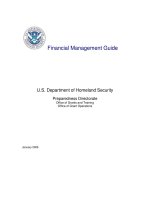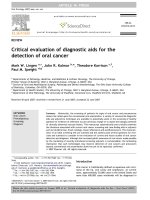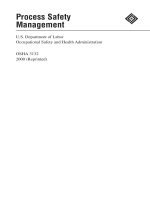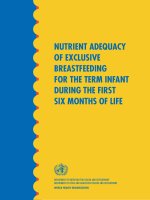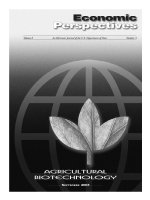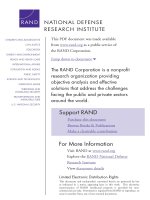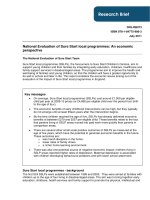Outcome Evaluation of U.S. Department of State Support for the Global Methane Initiative doc
Bạn đang xem bản rút gọn của tài liệu. Xem và tải ngay bản đầy đủ của tài liệu tại đây (559.28 KB, 100 trang )
Environment, Energy, and Economic Development Program
For More Information
Visit RAND at www.rand.org
Explore the RAND Environment, Energy, and Economic
Development Program
View document details
Support RAND
Purchase this document
Browse Reports & Bookstore
Make a charitable contribution
Limited Electronic Distribution Rights
is document and trademark(s) contained herein are protected by law as indicated in a notice appearing
later in this work. is electronic representation of RAND intellectual property is provided for non-
commercial use only. Unauthorized posting of RAND electronic documents to a non-RAND website is
prohibited. RAND electronic documents are protected under copyright law. Permission is required from
RAND to reproduce, or reuse in another form, any of our research documents for commercial use. For
information on reprint and linking permissions, please see RAND Permissions.
Skip all front matter: Jump to Page 16
e RAND Corporation is a nonprot institution that helps improve policy and
decisionmaking through research and analysis.
is electronic document was made available from www.rand.org as a public service
of the RAND Corporation.
CHILDREN AND FAMILIES
EDUCATION AND THE ARTS
ENERGY AND ENVIRONMENT
HEALTH AND HEALTH CARE
INFRASTRUCTURE AND
TRANSPORTATION
INTERNATIONAL AFFAIRS
LAW AND BUSINESS
NATIONAL SECURITY
POPULATION AND AGING
PUBLIC SAFETY
SCIENCE AND TECHNOLOGY
TERRORISM AND
HOMELAND SECURITY
is product is part of the RAND Corporation technical report series. Reports may
include research ndings on a specic topic that is limited in scope; present discussions
of the methodology employed in research; provide literature reviews, survey instru-
ments, modeling exercises, guidelines for practitioners and research professionals, and
supporting documentation; or deliver preliminary ndings. All RAND reports un-
dergo rigorous peer review to ensure that they meet high standards for research quality
and objectivity.
Environment, Energy, and Economic Development Program
TECHNICAL REPORT
Outcome Evaluation of
U.S. Department of State Support
for the Global Methane Initiative
Nicholas Burger • Noreen Clancy • Yashodhara Rana • Rena Rudavsky
Aimee E. Curtright • Francisco Perez-Arce • Joanne K. Yoong
Sponsored by the U.S. Department of State
The RAND Corporation is a nonprofit institution that helps improve policy and
decisionmaking through research and analysis. RAND’s publications do not necessarily
reflect the opinions of its research clients and sponsors.
R
®
is a registered trademark.
© Copyright 2013 RAND Corporation
Permission is given to duplicate this document for personal use only, as long as it
is unaltered and complete. Copies may not be duplicated for commercial purposes.
Unauthorized posting of RAND documents to a non-RAND website is prohibited. RAND
documents are protected under copyright law. For information on reprint and linking
permissions, please visit the RAND permissions page (
permissions.html).
Published 2013 by the RAND Corporation
1776 Main Street, P.O. Box 2138, Santa Monica, CA 90407-2138
1200 South Hayes Street, Arlington, VA 22202-5050
4570 Fifth Avenue, Suite 600, Pittsburgh, PA 15213-2665
RAND URL:
To order RAND documents or to obtain additional information, contact
Distribution Services: Telephone: (310) 451-7002;
Fax: (310) 451-6915; Email:
Library of Congress Cataloging-in-Publication Data
Burger, Nicholas.
Outcome evaluation of U.S. Department of State support for the Global Methane Initiative / Nicholas Burger,
Noreen Clancy, Yashodhara Rana, Rena Rudavsky, Aimee E. Curtright, Francisco Perez-Arce, Joanne K. Yoong.
pages cm
Includes bibliographical references.
ISBN 978-0-8330-7672-4 (pbk. : alk. paper)
1. Greenhouse gas mitigation—Government policy—United States. 2. Greenhouse gas mitigation—United
States—Evaluation. 3. Methane—Environmental aspects. 4. United States. Dept. of State—Evaluation. I. Title.
TD885.5.G73B87 2013
363.738'7460973—dc23
2013000708
This research was sponsored by the U.S. Department of State and was conducted in the
Environment, Energy, and Economic Development Program within RAND Justice,
Infrastructure, and Environment, a division of the RAND Corporation.
iii
Preface
Methane emissions account for approximately one-third of anthropogenic climate forcing, or
the heat-trapping eect of greenhouse gas emissions. Reducing methane emissions has increas-
ingly become a goal for governments concerned about climate change. Because of the value
of methane as a fuel (it is the main component of natural gas), consumers and producers have
been interested in both the economic value and the environmental benets of reducing meth-
ane emissions. is report evaluates U.S. Department of State (DoS) support for the Global
Methane Initiative (GMI). GMI is an international partnership program that promotes cost-
eective methane recovery and use by supporting public- and private-sector emissions reduc-
tion eorts. DoS—specically, its Bureau of Oceans and International Environmental and
Scientic Aairs (OES) and Oce of Global Change (EGC)—has supplied funding to GMI
totaling $27 million between scal years 2006 and 2010 and requested an evaluation of the
activities and outcomes that it supported in whole or in part during that period.
e evaluation used quantitative and qualitative methods to describe and assess the eect
of DoS support for GMI’s methane reduction eorts. We also provide recommendations for
the program and future evaluation eorts. Although the primary audience for this report is
OES/EGC sta, the results should also be of interest to policymakers and stakeholders who
are interested in voluntary actions by the public and private sectors to reduce greenhouse gas
emissions.
The RAND Environment, Energy, and Economic Development Program
is research was conducted in the Environment, Energy, and Economic Development Pro-
gram (EEED) within RAND Justice, Infrastructure, and Environment (JIE). e mission of
RAND JIE is to improve the development, operation, use, and protection of society’s essential
physical assets and natural resources and to enhance the related social assets of safety and secu-
rity of individuals in transit and in their workplaces and communities. e EEED research
portfolio addresses environmental quality and regulation, energy resources and systems, water
resources and systems, climate, natural hazards and disasters, and economic development—
both domestically and internationally. EEED research is conducted for government, founda-
tions, and the private sector.
Questions or comments about this report should be sent to the project leaders, Nicholas
Burger () or Noreen Clancy (). Informa-
tion about the Environment, Energy, and Economic Development Program is available online
iv Outcome Evaluation of U.S. Department of State Support for the Global Methane Initiative
( Inquiries about EEED projects
should be sent to the following address:
Keith Crane, Director
Environment, Energy, and Economic Development Program, JIE
RAND Corporation
1200 South Hayes Street
Arlington, VA 22202-5050
703-413-1100, x5520
v
Contents
Preface iii
Figures and Tables
ix
Summary
xi
Acknowledgments
xix
Abbreviations
xxi
CHAPTER ONE
Introduction 1
Methane as a Greenhouse Gas
2
e Global Methane Initiative
2
e Structure of GMI
3
Role of the United States and DoS in GMI
4
Steering Committee
5
Technical Subcommittees
5
Administrative Support Group
5
U.S. Funding Contributions to GMI
6
Evaluation Approach
8
Value Added
9
GMI Evaluation Metrics
10
Organization of is Report
11
CHAPTER TWO
Quantitative Analysis of DoS Contributions to GMI Funding, Activities, and Outcomes 13
Quantitative Analysis Approach
13
e GMI Database and How We Used It
14
USG Financial Support
16
e Role of Contracts and Grants
17
Activities and Participation
18
Activities
19
Training
22
Emissions Reductions
23
Measuring Reductions in Methane Emissions Using GMI Data
23
Estimates of Reductions in Methane Emissions
26
Gender-Related Outcomes
28
vi Outcome Evaluation of U.S. Department of State Support for the Global Methane Initiative
Leveraged Funding 29
Summary
31
CHAPTER THREE
Qualitative Observations of DoS Contributions 33
Site Visits
34
Site Selection Process
34
Data Analysis
35
India
36
Site Visit Description
37
Impacts
38
Funding
40
Views of GMI and Suggestions for Improvement
41
Mexico
42
Site Visit Description
42
Impacts
43
Funding
45
Views of GMI and Suggestions for Improvement
46
e Philippines
47
Site Visit Description
47
Impacts
47
Funding
51
Views of GMI and Suggestions for Improvement
52
Feedback from Nongovernmental Organizations
52
Observations from Site Visits
53
Knowledge of DoS Involvement Was Limited
53
GMI Is Increasing the Momentum for Methane Reduction Activities
53
Local Presence and Demonstration Eorts Have Been Eective
54
DoS Value Added in GMI Programmatic Activities
55
Establishment of GMI
55
Programmatic and Strategic Guidance
55
CHAPTER FOUR
Findings and Recommendations 57
Key Findings
57
DoS Funding for GMI Has Been Substantial
57
DoS Has Supplied Strategic and Programmatic Support
57
Site Visits Suggest at GMI Activities Are Seeding Methane Reduction Eorts
58
Recommendations
58
Soliciting Feedback from Project Participants
58
GMI Database
58
Tracking GMI Emissions Reductions
59
Assessing the Evaluation Metrics
60
Leveraged Funding
61
DoS in a Supporting Role
62
Opportunities for Future Program Evaluation
62
Contents vii
APPENDIXES
A. GMI Partner Countries 65
B. Site Visit Interview Protocol
67
C. Ideas for Establishing Performance Metrics for Gender Impacts
71
D. Site Visits: Site Selection Process, Protocol Development, and Contacting
Respondents
73
Bibliography
75
ix
Figures and Tables
Figures
S.1. Evaluation Framework xiii
1.1. Evaluation Framework
8
Tables
1.1. Share of Total U.S. Government Support for GMI, by Agency, FYs 2006–2010 6
1.2. Breakdown of DoS GMI Expenditures
7
2.1. Summary of Evaluation Metrics Addressed Using Quantitative Data
13
2.2. GMI Funding, by Fiscal Year
16
2.3. GMI Funding, by Region and Fiscal Year
17
2.4. GMI Activities, by Year
19
2.5. Share of GMI Activities, by Region and Year
20
2.6. USG-Funded GMI Activities, by Region and Sector
21
2.7. GMI Activities, by Type and Year
21
2.8. Total Participation in GMI Activities Recorded in the GMI Database
23
2.9. Summary of Emissions Reduction Tracking Methodologies, by Sector
25
2.10. Actual Emissions Reductions Recorded in the GMI Database
27
2.11. Emissions at Could Lead Directly to Emissions Reductions, by Activity Type
27
2.12. Actual USG-Attributable Emissions Reductions, by Region
28
2.13. Female Participation in GMI Activities Recorded in the GMI Database
29
2.14. Annual USG Funding and Leveraged Funding, FYs 2006–2010
30
3.1. India Site Visit Summary
37
3.2. Mexico Site Visit Summary
43
3.3. Philippines Site Visit Summary
48
xi
Summary
Methane is a greenhouse gas (GHG) that has more than 20 times the warming power of carbon
dioxide (CO
2
) but remains in the atmosphere for a shorter amount of time.
1
Methane emis-
sions are released during the course of a wide range of activities: the production and transport
of coal, natural gas, and oil; raising livestock and other agricultural practices; and the decay
of organic waste in municipal solid waste landlls and some wastewater treatment systems.
In 2004, 14 countries came together under the leadership of the United States to launch the
Methane to Markets Partnership. e program was relaunched in 2010 as the Global Methane
Initiative (GMI). GMI promotes cost-eective, near-term methane recovery internationally
through partnerships between developed and developing countries, with participation from
private sector, development banks, and other governmental and nongovernmental organiza-
tions. GMI is part of the U.S. strategy to address GHG emissions and their impact on climate
change.
As one of the two primary U.S. agencies participating in GMI, the U.S. Department of
State (DoS)—specically, its Bureau of Oceans and International Environmental and Scien-
tic Aairs (OES) and Oce of Global Change (EGC)—requested a study to “document
and evaluate programmatic activities and outcomes relative to the contributions of OES/
EGC funding from scal years 2006 through 2010.” OES/EGC requested an evaluation that
described the value added of DoS contributions to the program, including a discussion of the
countries and programmatic themes that were supported as a result of OES/EGC funding.
ey also requested that the evaluation apply a mixed-methods approach, using both quanti-
tative and qualitative information, to document and illustrate program outcomes, including
information from in-country site visits. DoS commissioned the RAND Corporation to con-
duct this assessment.
U.S. Government Support for GMI and the Role of DoS
GMI is a voluntary program that facilitates partnerships between member countries and pri-
vate organizations, and the U.S. government (USG) provides nancial and technical assistance
to support the program and its goals. GMI’s aims are to reduce methane emissions by rais-
ing global awareness about methane challenges and solutions, reducing institutional barriers,
promoting learning, and facilitating knowledge-sharing. GMI is focused on reducing meth-
1
Based on its 100-year global warming potential.
xii Outcome Evaluation of U.S. Department of State Support for the Global Methane Initiative
ane emissions across four sectors: agriculture, coal mines, landlls, and oil and gas systems.
2
USG funding supports activities across these four sectors, including feasibility studies, training
workshops, demonstration projects, conferences, knowledge-sharing and dissemination oppor-
tunities, and eorts to facilitate technology transfer.
USG-supported activities promote methane reduction both directly and indirectly. For
example, methane recovery demonstration projects reduce emissions directly, and those reduc-
tions can be measured. GMI works to facilitate emissions reductions indirectly, too. For exam-
ple, some communities or organizations are unaware of the potential impact of methane reduc-
tion projects or do not know how to obtain the necessary nancial and government assistance
to initiate such a project. USG-supported educational eorts often take the form of meetings,
conferences, training sessions, and workshops. ese types of activities help participants share
knowledge, build technical capacity, and promote other indirect outcomes that contribute to
reductions in methane emissions.
GMI is led by a steering committee and four technical subcommittees (one for each
sector), which include representatives from GMI partner countries. Both DoS and the U.S.
Environmental Protection Agency (EPA) sit on the GMI Steering Committee, of which EPA
serves as the chair. e committee provides overall direction to GMI. As a U.S. representative
on the Steering Committee, DoS works with the other members to ensure that eorts under-
taken by GMI are the best way to advance the program’s goals and objectives. DoS also brings
the U.S. foreign policy perspective to bear when guiding GMI’s programmatic activities and
strategic direction. GMI’s Administrative Support Group (ASG) is hosted by EPA and serves
as the secretariat, the main organizing and coordinating body. DoS assists the ASG with dip-
lomatic interactions with partner countries and in identifying and engaging new potential
partner countries.
Evaluation Approach
We evaluated DoS contributions to GMI using a mixed-methods approach that combined
quantitative and qualitative data to characterize the DoS resources provided to GMI in scal
years (FYs) 2006–2010, to identify the activities that GMI conducted with DoS support, and
to assess the resulting achievements. Our focus was on DoS valued added—the additional
benets of the department’s nancial and nonnancial contributions above and beyond other
USG and non-USG support.
To assess value added, DoS contributions must be examined in the context of the overall
program, since GMI is an integrated eort of DoS, EPA, and other stakeholders. We attempted
to capture DoS contributions to GMI in two ways. First, we considered its share of the total
nancial support provided by the USG. We argue that DoS ought to be credited with at least
the share of outputs and outcomes proportionate to its nancial contribution. Second, we
identied specic or unique contributions that DoS has made to the program, such as foreign
policy guidance or exible travel support, which other USG funders have been less able to
provide.
2
In 2011, GMI added a wastewater systems sector, but because wastewater activities were part of the landlls sector
during the study period, in this report we restrict our focus to the four original sectors.
Summary xiii
We rst examined the GMI program as a whole. We reviewed the nancial and techni-
cal resources that the USG has contributed to the program (the inputs), the activities that have
been undertaken on behalf of the program (the outputs), and results of those activities (the out-
comes). We focused specically on DoS contributions, including funding and strategic guid-
ance. Because it is dicult to measure some outcomes, especially indirect outcomes, we used
both quantitative and qualitative data to assess the activities and outcomes tied to OES/EGC
funding and the value added of that support. We analyzed the available quantitative informa-
tion and supplemented it with qualitative information from interviews and site visits.
Figure S.1 shows a simplied diagram of the key evaluation features in the context of the
basic GMI program structure. Our evaluation focused on GMI inputs, outputs, and outcomes
(shown at the top of the gure), which are related to specic program components (shown
in the second panel). We drew on both qualitative and quantitative data (the third panel in
the gure) to assess funding and strategic support (inputs), activities (outputs), and emissions
reductions, institutional changes, and policy eects (outcomes). e nal panel shows the pri-
mary sources of data on which we drew to assess each program component. e bolded boxes
and text indicate the main focus of our evaluation, which was to assess DoS contributions to
GMI, although these contributions are an integral part of the overall program. e red text
indicates the core evaluation metrics, which we describe next.
To assess outcomes, we focused on a set of ve evaluation metrics (shown in red text in
Figure S.1). We drew on two sources to dene the core evaluation metrics. First, we consid-
Figure S.1
Evaluation Framework
RAND TR1250-S.1
Inputs OutcomesOutputs
Program
components
GMI Program
Gender effects
• Emissions
reduced
• Institutional
outcomes
• Policy
outcomes
• Knowledge
shared
• Capacity built
Qualitative
Quantitative
Qualitative
Primary
type(s) of
information
used
Quantitative
Qualitative
Quantitative
Qualitative
USG interviews
GMI database
Interagency
agreements
USG interviews
Primary
data
sources
GMI database
Site visits
GMI database
Site visits
USG interviews
DoS
• Funding
• Policy/strategic
contributions
EPA
• Funding
• Technical
knowledge
Other USG and
non-USG
contributions
• EPA staff support
• DoS staff support
• ASG
• Committees
• Contractors
• Grantees
• Activities
• Training
• Leveraged
funding
xiv Outcome Evaluation of U.S. Department of State Support for the Global Methane Initiative
ered GMI’s contributions to the four OES/EGC performance indicators, as outlined in the
evaluation solicitation: policy outcomes, training, institutional capacity, and emissions reduc-
tions. We added to that set the metrics that the USG identies as central to assessing its GMI
support: emissions reductions, leveraged funding, and training. Because there was overlap
between these sets of metrics, we consolidated them into ve categories:
1. emissions reductions
2. leveraged funding
3. training
4. institutional outcomes
5. policy outcomes.
We also assessed the gender dimensions of these outcomes, where applicable and feasible,
as requested in the solicitation. We summarized the metrics emissions reductions, leveraged
funding, and training using EPA data. We were able to assess policy outcomes to a limited
extent based on data and information gathered during site visits in three countries and from our
interviews. Information to evaluate institutional outcomes, however, was almost nonexistent.
We organized the evaluation around the quantitative and qualitative data we compiled
and collected, which provided complementary yet distinct insights into DoS contributions
to GMI. For quantitative data, we compiled information on the amount of OES/EGC fund-
ing that was provided to GMI compared to total USG expenditures on the program for
FYs 2006–2010. We also pulled data from EPA’s GMI database—a system for tracking GMI
activities and associated funding—on all GMI activities and outcomes funded by DoS (as part
of USG contributions to GMI), by year, sector, and country.
3
For qualitative data, we exam-
ined program documentation, reviewed programmatic guidance in DoS funding documents,
conducted interviews with relevant program ocers in DoS and EPA, and carried out three
country site visits. is approach allowed us to draw on complementary data sources to assess
DoS contributions in terms of the aggregate share of GMI activities funded, their associated
outcomes, and the specic administrative and programmatic contributions from DoS.
Findings
During the course of this evaluation, we found evidence that GMI has contributed to reduc-
ing emissions of methane. Of the approximately 2,000 activities initiated between FYs 2006
and 2010 in EPA’s GMI database, 542 have reportedly contributed to reductions in emissions
totaling 203 million metric tons of CO
2
equivalent (MMTCO
2
e), equal to approximately
one-third of total U.S. methane emissions in 2010. Although many factors contribute to emis-
sions reductions, the scale of the decline in emissions reported by GMI is large. e actions of
the international community also provide evidence that GMI is viewed as a useful eort. e
number of countries that are members of GMI increased from 14 in 2004 to 41 in 2011, sug-
gesting that there is substantial interest in the approach the program takes to addressing global
climate change.
3
EPA refers to this database internally as the Customer Relationship Management database, or CRM.
Summary xv
DoS has played a major role in providing USG support for GMI, especially in areas where
DoS has stronger expertise than EPA, such as diplomacy and foreign policy guidance. DoS
nancial contributions to GMI have been substantial, accounting for slightly more than half of
all USG funding for the program. e activities supported by DoS contributions—along with
EPA’s appropriations and other USG nancial support—have contributed to approximately
150 MMTCO
2
e in methane emissions reductions of the 203 MMTCO
2
e reported by GMI,
although we acknowledge that some of these data are dicult to verify.
Funding provided by DoS in conjunction with funding and technical assistance from
EPA supported as many as 2,000 GMI-related activities, from training to reduce methane
emissions from municipal waste facilities to pilot projects to reduce the leakage of natural gas
from pipelines and coal mines. Without the funding—and the greater exibility that DoS has
than EPA to make some types of expenditures for program support—GMI’s ability to pursue
these activities and bring about the associated reductions in GHG emissions would have been
greatly curtailed.
Quantitative Findings
Between FY 2006 and FY 2010, total USG funding for GMI was approximately $54 million;
EPA and DoS were the primary funders. DoS monetary contributions were approximately
$27 million, or 52 percent of total GMI funding. USG funds were used to support GMI
activities around the globe, ranging from large-scale conferences and expositions to small-scale
projects to reduce agricultural methane in developing countries. ese activities resulted in
both direct outcomes (e.g., reduced emissions) and indirect outcomes (e.g., improved techni-
cal capacity), although we can quantify the latter only through levels of output, such as people
trained. EPA’s GMI database captures approximately 2,000 GMI-related activities between
2005 and 2011 and directly associates USG funding with 1,095 of those activities.
4
According
to EPA, many of the remaining 900 activities were also supported by DoS and EPA funding,
but the funding information is missing or incomplete. Activities may have also been funded by
GMI partners, Project Network members, or other stakeholders.
e 2,003 activities undertaken by GMI between 2006 and 2011 were relatively con-
sistent in terms of sector served, project type, and region. GMI funding from all donors is
co-mingled; thus, the GMI database did not allow us to ascribe specic funding amounts to
specic activities. Consequently, we ascribed DoS value added to GMI activities and associated
quantitative outcomes (emissions reduced) based on the 52 percent of total funding that DoS
provided in support of GMI.
According to the GMI database, between 2006 and 2011 more than 15,000 people par-
ticipated in GMI activities. We have categorized this participation by type of activities to focus
on those that were designed specically to promote learning or capacity-building. is subset
of activities included approximately 45 percent of all recorded participants, with approximately
6,900 people reported to have attended a GMI-aliated training session or workshop during
our study period. Nearly all of these training sessions or workshops were funded at least in part
by DoS and EPA. Of the 203 MMTCO
2
e in methane emissions reductions recorded by GMI,
the 532 USG-supported activities accounted for 146 MMTCO
2
e, equal to about a quarter of
all methane emissions from the United States in 2010.
4
In our study, we included data for 2011 because DoS FY 2010 funding supported activities in calendar year 2011.
xvi Outcome Evaluation of U.S. Department of State Support for the Global Methane Initiative
Some GMI activities do not directly lead to emissions reductions: ey are designed to
build local capacity and transfer knowledge, which can lead to the spread of technologies and
changes in business and other practices that could result in emissions reductions. If we restrict
the number of activities we credit for reducing emissions to only those that were designed to
lead directly to emissions reductions, then 540 (of 1,271, or 42 percent) of these activities
directly contributed to reduced emissions.
Qualitative Findings
Site Visits
e RAND team’s site visits captured more detailed qualitative evidence of DoS contribu-
tions to GMI, albeit for a limited set of countries and activities. During our site visits to India,
Mexico, and the Philippines, we interviewed 32 individuals involved with approximately
30 distinct activities and visited six eld sites. e goal of the country site visits was to under-
stand how GMI activities were executed locally, to assess the nature of relationships among
several stakeholders, and to gather richer information than that available from the GMI data-
base about the activities conducted and their eects. e site visits were particularly useful in
providing insights into the outcomes of GMI-funded activities that did not directly result in
emissions reductions. e site visits also provided an opportunity to collect data from respon-
dents to validate recorded program data.
Most respondents working in the four GMI sectors reported that USG-funded activities
in support of GMI had helped educate industry and government leaders about the potential
benets of reducing methane emissions and about the potential to use methane collected from
these activities as a fuel. In India, respondents working in both the landll and coal sectors
mentioned that GMI had resulted in increased initiatives to reduce methane emissions. In
the Philippines, capacity-building activities, such as training, helped institutionalize methane-
reducing practices, and the country’s involvement with GMI has encouraged several agencies
to establish a national equivalent, the Philippine Methane Initiative, whose aim is to develop a
nationwide strategic plan for methane recovery and capture across the Philippines.
Stakeholders from both the private and public sectors stated that they beneted from
capacity-building activities, such as study tours, conferences, and workshops, which gave them
opportunities to learn about new technologies and network with leading international par-
ticipants in their elds. ese outcomes are hard to quantify and thus missing in the GMI
database, but they were frequently cited by respondents during our site visits. ese programs
provided respondents with exposure to ideas and approaches that they otherwise would not
have encountered.
e majority of our interviewees reported nding cross-sector activities benecial, and
they hoped that there would be an increase in such activities in the future. Comparing results
across the three country case studies, we found that sectors that are fragmented and involve
several organizations (e.g., agriculture) have a greater need for networking support than other,
more consolidated sectors (e.g., oil and national gas, often run by one national agency). Frag-
mented sectors may benet from additional funding or a local GMI representative who is
able to coordinate activities among private, public, and community partners—a strength we
observed in the Philippines. Participants also felt that industries characterized by small private
rms would benet from more demonstration projects.
Summary xvii
Programmatic and Strategic Support
In addition to its monetary contributions, DoS provides programmatic and strategic guidance
to GMI. DoS was heavily involved in the creation of GMI and continues to play an ongoing
role through its participation in the Steering Committee and ASG. During GMI’s formation,
DoS contributed its skills in drafting multilateral agreements, especially when crafting the
chartering documents, and engaged its core competence in diplomacy and building consent
to create the partnership. DoS also engages in outreach to non-partner countries that it feels
would be eective additions to GMI. DoS is able to use its knowledge and expertise to iden-
tify the appropriate ministers and to pursue the approaches that are likely to appeal to specic
countries. DoS is also able to apply its diplomatic skills and international relations expertise
when providing strategic and programmatic guidance to GMI.
Based on statements from DoS and EPA sta, without DoS nancial and strategic sup-
port, GMI would be a very dierent and much smaller program than it is today. In our assess-
ment, without DoS support, GMI’s scope would probably have been reduced by more than
half, because there are xed costs associated with administering the program. In addition, DoS
provides strategic and foreign policy guidance that falls outside EPA’s technical expertise, a
unique contribution given GMI’s international structure. is contribution was mentioned by
both EPA and DoS sta.
Recommendations
Based on our understanding of how GMI operates, the evolving role of DoS in GMI, and the
data collection and management systems EPA maintains to track, assess, and report program
accomplishments, we drew up some recommendations for ways to enhance DoS contributions
and value added to GMI. We also identied opportunities to improve GMI data collection,
especially to support future program evaluation.
Soliciting Feedback from Project Participants
In our interviews, we found that local stakeholders were aware of problems in implementing
projects but felt that they lacked avenues through which to convey these observations to the
USG. DoS should consider supporting a process to expand the channels through which stake-
holders can provide information to program leaders that will help improve GMI.
Assessing the Evaluation Metrics
Metrics such as emissions reduced are relatively easy to measure and closely align with GMI’s
goals. Other metrics, such as capacity built, also closely align with GMI’s goals but are more
dicult to measure. In contrast, some of the metrics concerning impacts related to gender
do not necessarily align well, based on our conversations with a range of GMI stakeholders.
Because measurement often drives program focus, relatively weak alignment between metrics
and program objectives can potentially distort performance. Overly narrow metrics, with cor-
responding annual targets, may result in funding being driven toward projects that “count,”
such as training programs for women, rather than on eorts focused on education, knowledge
transfer, or partnership-building, which may have a greater eect on the long-term goal of
reducing methane emissions. Overly broad metrics may reward “quantity” rather than “qual-
xviii Outcome Evaluation of U.S. Department of State Support for the Global Methane Initiative
ity.” EPA and DoS should consider developing appropriately tailored evaluation metrics as the
program moves forward.
Leveraged Funding
Leveraged funding is an important potential benet of DoS support for GMI. DoS funding
can encourage other public- and private-sector entities to contribute additional funding to
eorts to reduce methane emissions. But leveraged funding is challenging to measure. Cur-
rent information on leveraged funding in the GMI database appears to conate funding that
“leverages” U.S. funds (“augments or builds upon an activity or eort funded by the U.S.,”
as stated in EPA’s leveraged funding methodology) and funding from any source other than
the USG that supports methane reductions (EPA, 2011a). We recommend that EPA and DoS
develop standards for how leveraged funding is identied, what constitutes leveraged funding,
and how much of the funding is designated as leveraged. is would lend additional credibility
to reports on leveraged funding.
DoS Should Maintain a Supporting Role
DoS has provided substantial funding to support GMI, and it has also made important strate-
gic contributions. However, DoS has put relatively few restrictions on how its funding should
be allocated (e.g., across sectors or regions), and it allows EPA to play a lead role in managing
USG support for GMI. We view this exibility as benecial. We recommend that DoS con-
tinue to provide high-level guidance and support while allowing EPA to drive the process of
identifying technical opportunities and guiding USG funding allocations to the maximum
extent feasible.
Opportunities for Future Program Evaluation
Based on our assessment of DoS support for GMI, we identied three activities that could
supplement a long-term evaluation strategy and provide near-term insights into GMI’s eec-
tiveness, potentially at a relatively low cost:
• Conduct targeted surveys of individuals participating in GMI activities to assess
– the types of benets that GMI stakeholders perceive to be most valuable
– the types and extent of information that stakeholders gain through participating in
GMI activities.
• Assess both successful and unsuccessful grant applications—those just above and just
below the cuto line. is exercise could identify the topics for which USG support is piv-
otal versus topics for which there are potentially other available funding sources, allowing
EPA and DoS to better target their resources.
• Construct a logic model, a necessary step to facilitate a process evaluation of GMI, that
examines whether the program’s activities and outputs are in line with its mission and are
helping GMI achieve its goals.
xix
Acknowledgments
We thank GMI program ocers Barbara DeRosa-Joynt and Andrew Eil at the U.S. Depart-
ment of State for sharing their insights with us. Grin ompson, also at the Department of
State, was helpful in dening the research process, as was Nancy Ahson in providing historical
documentation and managing the grant. We also thank the sta of the Environmental Protec-
tion Agency who have worked in support of GMI for explaining program details, providing
program documentation, and being responsive to our many requests and questions. In particu-
lar, we thank Paul Gunning, Pamela Franklin, Henry Ferland, and Monica Shimamura for
their support. We are grateful to all those whom we interviewed during our site visits who were
gracious with their time and attention. We also acknowledge comments and suggestions from
our two reviewers, Shanthi Nataraj of RAND and Tom Lyon of the University of Michigan.
xxi
Abbreviations
ASG Global Methane Initiative Administrative Support Group
BAI Philippine Bureau of Animal Industry
CBM coal bed methane
CDM Clean Development Mechanism
CMM coal mine methane
CO
2
carbon dioxide
co-op cooperative
DAP Development Academy of the Philippines
DoS U.S. Department of State
DOST Philippines Department of Science and Technology
EEED RAND Environment, Energy, and Economic Development Program
EGC Oce of Global Change, U.S. Department of State
EPA U.S. Environmental Protection Agency
FY scal year
GHG greenhouse gas
GMI Global Methane Initiative
IAA interagency agreement
IQR identication, quantication, and reduction
JIE RAND Justice, Infrastructure, and Environment
LFG landll gas
MMSCM million metric standard cubic meters
MMTCO
2
e million metric tons of carbon dioxide equivalent
MTCO
2
e Metric tons of carbon dioxide equivalent
xxii Outcome Evaluation of U.S. Department of State Support for the Global Methane Initiative
NGO nongovernmental organization
NGSI Natural Gas STAR International
OES Bureau of Oceans and International Environment and Scientic Aairs,
U.S. Department of State
ONGC Oil and Natural Gas Corporation
PEMEX Petróleos Mexicanos
PMI Philippine Methane Initiative
TOR terms of reference
UN United Nations
USAID U.S. Agency for International Development
USG U.S. government
USTDA U.S. Trade and Development Agency
VAM ventilation air methane
1
CHAPTER ONE
Introduction
e Global Methane Initiative (GMI) is a voluntary international partnership program that
promotes cost-eective, near-term methane recovery and reuse activities in developing and
transition economies with participation from the private sector, development banks, and other
governmental and nongovernmental organizations. Methane is a short-lived greenhouse gas
(GHG) that has more than 20 times the atmospheric warming eect of carbon dioxide (CO
2
).
Recognizing the important role of methane in global warming and its potential use as a clean
energy source, 14 countries came together in 2004 under the leadership of the United States to
launch the Methane to Markets Partnership, which was relaunched as GMI in 2010.
e U.S. government (USG) has been a GMI partner since the program’s inception in
2004. e U.S. Department of State (DoS), specically, its Bureau of Oceans and Interna-
tional Environmental and Scientic Aairs (OES) and Oce of Global Change (EGC), has
been a major contributor to GMI, along with the U.S. Environmental Protection Agency
(EPA). OES/EGC requested a study to “document and evaluate programmatic activities and
outcomes relative to the contributions of OES/EGC funding from scal years 2006 through
2010.”
1
e agencies also requested an evaluation that describes their value added to the pro-
gram, including a discussion of the countries and programmatic themes that were funded as
a result of OES/EGC support to GMI. e evaluation applied a mixed methods approach,
using both quantitative and qualitative information, to document and illustrate program out-
comes, including information from three site visits. We did not, however, evaluate overall pro-
gram eectiveness (e.g., relative to other GHG reduction programs), nor did we assess whether
GMI’s process and focus was the right one, given its mission.
To assess value added, DoS contributions must be examined in the context of the overall
program, since GMI is an integrated eort of DoS, EPA, and other stakeholders. Implicitly, we
assessed GMI against a hypothetical version of the program that did not include DoS nancial
or strategic support. In other words, how have DoS contributions shaped the program that
GMI is today? We assessed DoS contributions to GMI—funding along with programmatic
and strategic support—using quantitative and qualitative information that we applied to mul-
tiple output and outcome measures. e remainder of this chapter includes a brief discussion
of methane as a GHG; a summary of the origins and structure of the GMI program, including
a nancial summary of USG support for the program; and a discussion of RAND’s approach
to the evaluation.
1
Taken from the request for applications announcement, funding opportunity number OES-OCC-11-004 (DoS, 2011).
